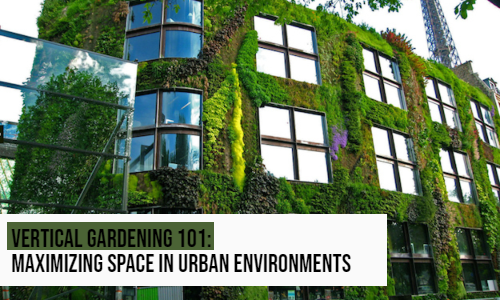Do you love urban gardening? If yes, then check out this article in order to learn about vertical gardening and its benefits.
Vertical gardening is a type of urban gardening. In order to maximize space and make use of vertical surfaces like walls, fences, and trellises, vertical gardening involves growing plants vertically. Vertical gardening can be done indoors as well as outdoors. A practical and aesthetically pleasing technique to cultivate plants in constrained locations is vertical gardening, which offers a number of advantages for people, communities, and the environment.
Benefits of Vertical Gardening
There are many benefits to vertical gardening. Some of the most common are
- Vertical planting makes the most of the available space. Instead of being cultivated outside, plants are cultivated in an upward orientation. This permits the use of vertical elements like poles and walls.
- In simple terms, urban gardening is gardening in a tiny area. One of its varieties, vertical gardening, may considerably widen the growing space. Growing more plants in a smaller space by using vertical structures enables the cultivation of a wider range of fruits, vegetables, and flowers.
- Vertical planting beautifies and aesthetically enhances the space. It will transform the area into a colorful and rich display of flora. With this, the environment will be more comfortable and pleasant.
- Vertical gardens, particularly when installed indoors, can contribute to cleaner and healthier air by increasing the number of plants in a given space.
- Vertical planting allows gardening to be done at a more comfortable height and with less bending or kneeling. Thus, people with physical limitations or mobility issues can now plant more conveniently.
- Additionally, it is thought that vertical gardens might operate as natural sound barriers to absorb and lower noise levels.
Techniques of Vertical Gardening
There are three main techniques involved in vertical gardening. These three techniques are
1. Trellising – Trellising is a useful method for vertical gardening that gives the garden greenery and beauty, makes better use of vertical space, and encourages healthier plant growth.
2. Tumbling – For adding a touch of elegance and vertical appeal to gardens, balconies, and other vertical gardening spaces, tumbling plants are a popular option.
3. Terracing – The use of sloped or hilly locations, maximizing growing space, and overcoming the difficulties presented by uneven terrain are made possible by the excellent vertical gardening technique of terracing.
In vertical gardening, trellising is a technique used to support climbing or vining plants. It includes the use of trellises, lattices, or other structures that plants can climb on as they grow. For plants like tomatoes, cucumbers, beans, peas, grapes, etc., trellising is frequently used.

Reasons for Trellising
There are several reasons for trellising. Some of the reasons are
- Trellising utilizes the vertical space effectively.
- With trellising, there is better exposure to sunlight and air, which leads to healthier growth and circulation.
- There is prevention against many soil-borne diseases and pests.
- These are more accessible for maintenance because of the position of the plants.
- Trellises and other vertical poles add more aesthetics, making the garden look more organized.
- Trellises can be used to separate different sections or to shield certain areas from view for protection and privacy.
Tumbling
Growing trailing or cascading plants vertically is known as tumbling. It involves arranging plants in a display that falls or cascades downward, utilizing hanging baskets, wall-mounted planters, or other vertical structures. It is used in small spaces or urban environments where horizontal gardening space is limited.

Reasons for Tumbling
A few of the reasons for tumbling are
- The use of vertical space is made possible through tumbling gardening.
- Tumbling plants add a sense of beauty and elegance to any garden or environment.
- Tumbling gardening is a productive gardening method because it makes the most of the available space. Utilizing vertical surfaces allows you to grow more plants in a smaller amount of space.
- Compared to taller or sprawling plants, tumbling plants are typically simpler to manage and care for. Additionally, this accessibility makes it easier to water, fertilise, and harvest crops because there is no need to squat or bend over.
- Tumbling plants can be deliberately placed to create natural screens or separators that provide privacy and hide unwanted sights.
Terracing
In vertical gardening, terracing is the process of building a progression of level platforms or steps on an incline or uneven terrain. To create flat planting surfaces, it includes constructing raised beds or retaining walls. Planning and building must be done carefully when terracing for vertical gardening.

Reasons for terracing
There are several reasons for terracing. Some of the most common are
- Control of soil erosion
- Improved drainage of water
- Increased planting area
- Accessible and easy to maintain
Conclusion
An efficient, room-saving, and visually beautiful method of gardening is vertical gardening. It has a number of advantages, including better aesthetics, easier maintenance, enhanced plant yield, and space optimization. Vertical gardening offers plenty of opportunities for individuals to design stunning and fruitful gardens in any environment thanks to its adaptability and versatility.
























